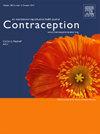2022 至 2023 年间全国代表性样本中有关堕胎安全的观念变化
IF 2.8
2区 医学
Q1 OBSTETRICS & GYNECOLOGY
引用次数: 0
摘要
方法 我们在多布斯诉杰克逊妇女健康组织案之前(2021 年 12 月/2022 年 1 月;n=6943)和多布斯案之后(2023 年 6 月/7 月;n=3533)对具有全国代表性的 15-49 岁 AFAB 受访者小组中讲英语或西班牙语的成员进行了两次连续横断面调查。我们要求参与者通过以下方式表明他们是否同意(从非常不同意到非常同意)"孕妇结束妊娠通常是安全的":(1) 在诊所内进行人工流产手术;(2) 使用在诊所或医生办公室获得的人工流产药片;(3) 使用在正规医疗系统外获得的人工流产药片。使用以年份为自变量的加权逻辑回归模型,我们评估了从多布斯事件前到多布斯事件后安全观念的变化,包括总体变化和各亚组之间的变化:57.8%增至64.1%(p<0.001);诊所内药物流产:52.2%增至59.6%(p<0.001):52.2%增至59.6%(p<0.001);在正规医疗系统外获得的药片:7.4%增至9.6%(p<0.001)。在分层分析中,与不同年份间安全性认可度增加相关的亚组包括认同民主党、无人工流产史以及支持诊所内程序性人工流产合法性的受访者(所有人工流产方法结果的 p<0.05 )。结论在一个具有全国代表性的样本中,尽管人工流产限制和声称人工流产不安全的政策不断增加,但在 2022 年至 2023 年期间,人们对人工流产方法安全性的信念有所增加。然而,公众对堕胎安全的了解仍然较少。本文章由计算机程序翻译,如有差异,请以英文原文为准。
CHANGES IN BELIEFS ABOUT ABORTION SAFETY IN A NATIONALLY REPRESENTATIVE SAMPLE BETWEEN 2022 AND 2023
Objectives
We aimed to estimate changes in beliefs about abortion safety among the US population assigned female at birth (AFAB) before and after Dobbs v Jackson Women’s Health Organization.
Methods
We administered two serial cross-sectional surveys to English- or Spanish-speaking members of a nationally-representative panel of AFAB respondents, ages 15-49, pre-Dobbs (December 2021/January 2022; n=6,943) and post-Dobbs (June/July 2023; n=3,533). We asked participants to indicate whether they agree (ranging from strongly disagree to strongly agree) “that it is usually safe for a pregnant person to end a pregnancy", by (1) having an in-clinic abortion procedure; (2) using abortion pills obtained at a clinic or doctor’s office; and (3) using abortion pills obtained outside the formal healthcare system. Using weighted logistic regression models with year as the independent variable, we assessed changes in safety beliefs pre- to post-Dobbs, both overall and among subgroups.
Results
Between 2022 and 2023, the proportion of respondents agreeing that each abortion method was “usually safe” increased: in-clinic procedure: 57.8% to 64.1% (p<0.001); in-clinic medication abortion: 52.2% to 59.6% (p<0.001); and pills obtained outside of the formal healthcare system: 7.4% to 9.6% (p<0.001). In stratified analyses, subgroups associated with increased endorsement of safety between years included respondents identifying as a Democrat, with no history of abortion, and who support in-clinic procedural abortion legality (p<0.05 for all abortion method outcomes).
Conclusions
In a nationally representative sample, belief that abortion methods are safe increased between 2022 and 2023 despite increasing abortion restrictions and policies claiming abortion is unsafe. Still, public knowledge about abortion safety remains low.
求助全文
通过发布文献求助,成功后即可免费获取论文全文。
去求助
来源期刊

Contraception
医学-妇产科学
CiteScore
4.70
自引率
17.20%
发文量
211
审稿时长
69 days
期刊介绍:
Contraception has an open access mirror journal Contraception: X, sharing the same aims and scope, editorial team, submission system and rigorous peer review.
The journal Contraception wishes to advance reproductive health through the rapid publication of the best and most interesting new scholarship regarding contraception and related fields such as abortion. The journal welcomes manuscripts from investigators working in the laboratory, clinical and social sciences, as well as public health and health professions education.
 求助内容:
求助内容: 应助结果提醒方式:
应助结果提醒方式:


